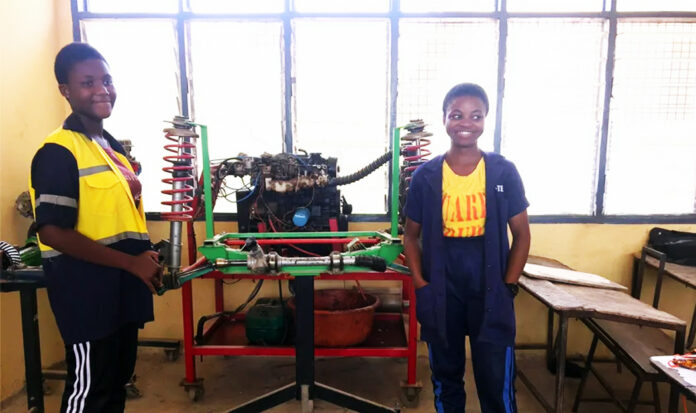Adolescent girls in Sub-Saharan Africa (SSA) are at a higher risk of dropping out of upper secondary school. According to UNESCO, over 19.3 million adolescent girls of upper secondary school age are out of school in SSA and for those who make it to upper secondary school, studying Science, Technology Engineering and Mathematics (STEM) particularly in technical education is improbable.
Nonetheless, girls like Esi and her colleagues who venture to study STEM in technical education in Ghana consider the opportunity as life changing.
The participation of girls in STEM is crucial
Ensuring that girls have equal opportunities to choose – and thrive in – STEM, especially in an increasingly digital and green world, can narrow the gender pay gap, improve economic security, ensure a diverse and talented labor force, and avert biases in products and services. However, less than 30% of graduates from tertiary education engineering programs in SSA are females, and out of these graduates only 20% are engineering workers.
Despite the staggering evidence, SSA countries and development partners continue to explore ways to improve girls’ education and access to STEM. In Ghana for instance, the Government’s free education policy and the recent strategy allowing flexibility for non-STEM students to switch to STEM programs are creating flexible access for girls.
The World Bank’s Western and Central Africa Education Strategy 2022-2025 aims to empower girls through schooling: increase girls’ secondary school gross enrollment rates from 41.9% to 46.9% and strengthen higher education and Technical Vocational and Education Training (TVET) systems to produce more employable graduates for inclusive growth.
The practical game changers attracting girls like Esi to STEM
Considering the aspiration to improve girls access to STEM and to understand why some girls “dare” to study STEM in technical education, researchers interviewed 26 young Ghanaian women studying STEM in technical secondary education.
Esi*, one of the participants explained that the applied nature of STEM in technical education, including practical lessons in school and integrated industry-based training, was attractive. The applied nature enabled her to solve real life problems and dispelled existing social stereotypes about girls’ inability to acquire and use STEM skills.

Aki also emphasized that flexible admissions in technical education changed the odds in her favor. Notwithstanding her average performance (grades B-C) in science and mathematics in her Basic Education Examination Certificate (BECE: the entrance examination for entry into upper secondary school education in Ghana), she gained admission to study computer hardware technology.
Additionally, Sika explained that the flexibility for her to switch from catering to refrigeration and air conditioning technology within the first year of admission was her chance to participate in STEM.
Other young women further narrated that studying STEM in technical education was a passport to multiple transition pathways, namely: entrepreneurship, employment, and further education. For Aku who was interested in entrepreneurship, she wants to set up her workshop in the future to contribute to job creation.
And Ata who is considering employment with a company, anticipates joining sectors that need her skills. Finally, Yaa, who had interest in further education, considers getting a tertiary education to make her more competitive in the labor market.
What can we learn from the narratives of Esi and her colleagues?
These narratives bring a stimulating perspective to how technical secondary education could be a game changer in the effort to increase the participation of girls in STEM. As countries in SSA consider viable ways to increase girls’ participation in STEM: governments could harness what these girls have shared .
Honing the applied approach of technical education through well-equipped workshops that have advanced digital technologies such as augmented and virtual reality; creating awareness about the multiple pathways for girls after studying STEM in technical education and making STEM admissions more flexible could attract more girls to choose and persist in STEM.
It is also important to recommend that governments need to invest in targeted remediation programs, including using adaptive learning technologies for girls with average academic performance to thrive in STEM.
The participation of girls in STEM is crucial now more than ever for SSA countries. And if the characteristics of technical education could change the game for more girls, then governments and their development partners must increase and sustain investments to enhance these enablers.
Not only can these enablers inspire more girls in SSA to pursue STEM education and occupations but change the lives of millions of girls and boys.
*For anonymity purposes, the names of the young students have been changed.
Source: World Bank









